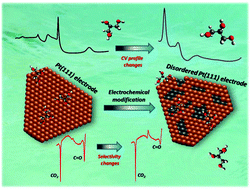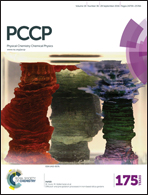How do random superficial defects influence the electro-oxidation of glycerol on Pt(111) surfaces?†
Abstract
The glycerol electrooxidation reaction (GEOR) has attracted huge interest in the last decade due to the very low price and availability of this polyol. In this work, we studied the GEOR on Pt(111) electrodes by introducing different densities of random defects. Our results showed that the generation of defects on Pt(111) slightly modified the GEOR onset potential, however it generates changes in the voltammetric oxidation charges and also in the relative production of CO2 to carbonyl containing compounds, C![[double bond, length as m-dash]](https://www.rsc.org/images/entities/char_e001.gif) O. The voltammetric profiles in the forward scan show two oxidation peaks. FTIR data show that the first one is connected with the GlOH dissociative adsorption to form CO (and others intermediates) while the second one, at higher potentials, matches the onsets of the CO oxidation to CO2 and the C
O. The voltammetric profiles in the forward scan show two oxidation peaks. FTIR data show that the first one is connected with the GlOH dissociative adsorption to form CO (and others intermediates) while the second one, at higher potentials, matches the onsets of the CO oxidation to CO2 and the C![[double bond, length as m-dash]](https://www.rsc.org/images/entities/char_e001.gif) O production. FTIR also confirms that the lower activity of defected electrodes at lower potentials is connected to a higher CO poisoning. DFT calculations show that the presence of CO molecules on a Pt defected surface keeps water and GlOH molecules far from the surface and linked by H bonds. This paper is the last of a series of three works where we explore the GEOR on an important number of different Pt surfaces. These works show that it is difficult to oxidize GlOH at potentials lower than 0.6 V (under our experimental conditions) without suffering an important electrode poisoning (mainly by CO). Since the structure of nanoparticles might be mimicked by defected single crystals, these sets of reports provide a considerable amount of information concerning the influence of such surfaces towards GlOH reaction in acidic media. Therefore, if the well-known “nano”-effect does not produce substantial changes in the activity of Pt materials, they are not useful to be applied in a Direct Glycerol Fuel Cell (DGFC). On the other hand, it is very interesting that the density of electrode defects permits us to tune the relative production of CO2 to C
O production. FTIR also confirms that the lower activity of defected electrodes at lower potentials is connected to a higher CO poisoning. DFT calculations show that the presence of CO molecules on a Pt defected surface keeps water and GlOH molecules far from the surface and linked by H bonds. This paper is the last of a series of three works where we explore the GEOR on an important number of different Pt surfaces. These works show that it is difficult to oxidize GlOH at potentials lower than 0.6 V (under our experimental conditions) without suffering an important electrode poisoning (mainly by CO). Since the structure of nanoparticles might be mimicked by defected single crystals, these sets of reports provide a considerable amount of information concerning the influence of such surfaces towards GlOH reaction in acidic media. Therefore, if the well-known “nano”-effect does not produce substantial changes in the activity of Pt materials, they are not useful to be applied in a Direct Glycerol Fuel Cell (DGFC). On the other hand, it is very interesting that the density of electrode defects permits us to tune the relative production of CO2 to C![[double bond, length as m-dash]](https://www.rsc.org/images/entities/char_e001.gif) O.
O.


 Please wait while we load your content...
Please wait while we load your content...